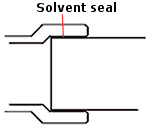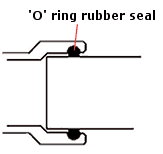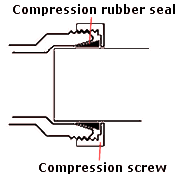Plastic waste pipes and connectors
Plastic waste pipe is available in 4 basic sizes (external diameter) for different plumbing uses:
- 21.5mm - for overflows such as cold water tank, cisterns etc
- 32mm - for hand basin waste pipe
- 40mm - for sink and bath waste pipe
- 110mm - for soil pipe and main drains
Types of plastics
Manufacturers use a variety of plastics for waste pipes and connectors, the most widely used are:
Acrylonitrile Butadiene Styrene (ABS) - A tough material suitable for both hot and cold waste water.
It normally incorporates a UV stabiliser which means it is suitable for both indoor and outdoor use. Suitable for all methods of joining.
Modified Unplasticised Polyvinyl Chloride M(uPVC) - A tough material suitable for both hot and cold waste water. Suitable for both indoor and outdoor use. Suitable for all methods of joining.
Polypropylene (PP) - A very tough but flexible material having a sort of waxy feel suitable for both hot and cold waste water.
Often the cheapest but usually It does not incorporate a UV stabiliser so should not be used outdoors; exposure to sunlight can cause it to become brittle over time. Not suitable for joining using solvent.
Methods of joining
Three different methods of joining and sealing pipes are available:
 Solvent: pipes and connectors of some types of plastic can be bonded together using a special solvent cement. These plastics tend to be the more expensive available but are easy to use. The major drawback of this type of waste pipes/connectors is that you only have one chance to make the connection, once connected there is no chance to adjust the angle or length without taking a hacksaw to the joint and remaking it with new pipe and connectors. If a joint is likely to be broken in the future for any reason, solvent type joints should not be used.
Solvent: pipes and connectors of some types of plastic can be bonded together using a special solvent cement. These plastics tend to be the more expensive available but are easy to use. The major drawback of this type of waste pipes/connectors is that you only have one chance to make the connection, once connected there is no chance to adjust the angle or length without taking a hacksaw to the joint and remaking it with new pipe and connectors. If a joint is likely to be broken in the future for any reason, solvent type joints should not be used.
 'O' ring: these connector can be used of all types of pipe of the appropriate diameter. To make a connection, the pipe is just pushed into the connector through the 'O' ring thus making the seal. Once the connection is made, the angle of the pipe/connector can be adjusted by gripping the pipe and connector (one in each hand) and twisting the pipe. If necessary to shorten lengths, the pipe can be pulled out, cut and re-inserted. To ease pushing the pipe into the connector, the end of the pipe should be lightly chamfered before insertion so that the pipe can easily start to enter the seal.
'O' ring: these connector can be used of all types of pipe of the appropriate diameter. To make a connection, the pipe is just pushed into the connector through the 'O' ring thus making the seal. Once the connection is made, the angle of the pipe/connector can be adjusted by gripping the pipe and connector (one in each hand) and twisting the pipe. If necessary to shorten lengths, the pipe can be pulled out, cut and re-inserted. To ease pushing the pipe into the connector, the end of the pipe should be lightly chamfered before insertion so that the pipe can easily start to enter the seal.
 Compression: Compression waste pipe connectors are often used to terminate waste pipes into the outlet of the waste trap under basins, baths and sinks. However inline connectors are also available using compression joints, these are the most expensive type available and their use is generally not warranted unless a particular bend or joint is likely to need to be broken on a regular basis. The compression screw and seal are removed from the connector and slid onto the pipe, the pipe is then inserted (requiring no effective effort) into the connection, the seal is then pushed along the pipe into the mouth of the connector and the screw is wound onto the connector making the seal compress between the pipe and the connector. To adjust or remove the pipe, the screw cover is undone thus releasing the seal, the pipe can then be adjusted or removed with no effective effort.
Compression: Compression waste pipe connectors are often used to terminate waste pipes into the outlet of the waste trap under basins, baths and sinks. However inline connectors are also available using compression joints, these are the most expensive type available and their use is generally not warranted unless a particular bend or joint is likely to need to be broken on a regular basis. The compression screw and seal are removed from the connector and slid onto the pipe, the pipe is then inserted (requiring no effective effort) into the connection, the seal is then pushed along the pipe into the mouth of the connector and the screw is wound onto the connector making the seal compress between the pipe and the connector. To adjust or remove the pipe, the screw cover is undone thus releasing the seal, the pipe can then be adjusted or removed with no effective effort.
110mm diameter Soil pipe and main domestic drainpipe
The main soil waste pipe is 110mm diameter, two types of plastic are used - one for the external down pipe and the other for below ground installation. The joints for soil pipes are normally large 'O' rings or similar circular, push fit seals. As with the smaller 'O' ring connectors, the pipe going into the joint should be chamfered to ease it passed the seal ring.
